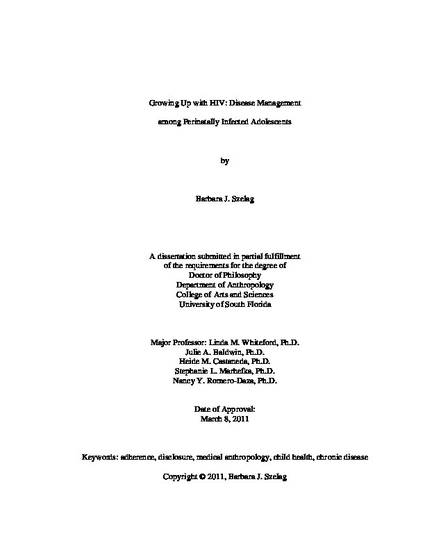
- adherence,
- disclosure,
- medical anthropology,
- child health,
- chronic disease
Children born with HIV in the 1980s and 1990s are surviving into adolescence and adulthood, due to the availability of highly active antiretroviral therapy (HAART). Growing up with a chronic and stigmatized disease presents considerable challenges as young people explore their sexuality, develop relationships, and take steps to become independent and productive adults. Adherence to HAART is an essential and life-long practice for the maintenance of health and longevity. For adolescents born with HIV, a daily medication schedule is one aspect of disease management that also includes medical visits, HIV status acceptance, bouts of illness, and disclosure of HIV status to others.
This research uses a framework of medical ecology to explore the personal, socio-familial, and medical contexts in which perinatally HIV-infected adolescents, as competent social actors, navigate the complexities of HIV disease management. It examines personal behaviors and attitudes, family dynamics, peer relationships, and health care structures and relationships that affect their adherence to HAART.
A key finding of this study was increased agency and adaptation to HIV among adolescents who learned their diagnosis earlier in life and whose caregivers demonstrated acceptance of HIV and support for the adolescents. They were able to adhere to their medication regimens, despite busy schedules, non-disclosure to friends, and treatment fatigue, and also had a somewhat better understanding of the medical aspects of HIV and HAART. Yet all of the adolescents had gaps in their understanding of clinical indicators and viral resistance, and the relationship between adherence and HIV transmission.
This deficit in a medical conceptualization and understanding of HIV and its ramifications is another important finding of this study. The adolescents' notions and actions regarding HIV disease, based on social, cultural, and medical norms and interactions within their environment, have a significant impact on the natural history of HIV. The level and consequent infectiousness of HIV as it responds to medications, mutates in their absence, and multiplies or is suppressed, depends on the individual's strict adherence to medications and attention to medical details, and affects HIV transmission to the individual's sexual partners. From both an individual medical and a public health perspective, an understanding of the ramifications of adherence and non-adherence to HAART is crucial. Early acceptance and understanding of HIV increase the possibility of successful medication adherence and overall disease management.
In order to facilitate perinatally-infected adolescents' disease management and adherence to medications, it is recommended that the process of disclosure of HIV diagnosis to the child begin early so that the child is fully aware by the age of ten. The acceptance of HIV in the family and clear-cut roles and responsibilities for disease management should be facilitated by ongoing instruction and counseling. Adolescents should be given thorough, if basic, instruction on the medical aspects of HIV, and should be encouraged to have friends, and especially sexual partners, accompany them to their clinic visits. This will encourage greater understanding of HIV and perhaps lead to less stigmatization of HIV and those living with HIV. Finally, providers and adolescent patients should construct a partnership in which their individual models of disease management are integrated and power and responsibility are appropriately shared.
Available at: http://works.bepress.com/barbara_szelag/1/